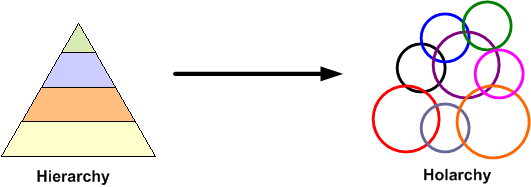In November 2014, Tony Hsieh, the CEO of Zappos, the billion dollar on-line shoe retailer, announced the company was moving to holarchy, an organizational structure with no job titles and no managers.
Instead of the typical hierarchy, fraught with bottlenecks, slow decision making, and concentrated power, the company will be organized into 400 circles, with each circle having a number of roles. The intent is “radical transparency” and extreme adaptability. In this model, the CEO has less power and all employees are expected to lead and to act entrepreneurially. Zappos and its 1500 partners (you and I would call them employees) will be the largest company to date to attempt this type of organizational structure.

The idea of a holacracy was founded and documented by Brian Robertson. In this structure, there are roles rather than job descriptions. Roles are work-focused, updated frequently, and one may have multiple roles. Decision making is distributed rather than centralized. Rather than a rigid structure which requires a major re-org to update, changes to the structure are done via smaller, continuous iterations. And finally, rather than office politics, governance is done via transparent rules that all play by.
And these transparent roles may be the Achilles heel of this structure. Robertson penned the Holacracy Constitution, a dense, legalistic, document of 30 pages. For those of you that don’t want to wade through the constitution, here is a quick summary of how it works.
What I Think Works with the this Model
I’ve long been an advocate of moving past job descriptions, which are typically out of date, inaccurate, descriptions of the work – that takes too much effort and time to update. Roles make sense to me, and a system which allows for multiple roles seems a more accurate reflection of the reality of today’s marketplace.
Circles resonate with me (no surprise there) and especially those that cross over traditional “silos”.
Shared leadership and making decisions at the lowest possible level are something I think any organization that wants to be effective today must figure out.
And agility in org design makes perfect sense – and anything one can do to promote the idea that jobs and roles are “fluid” rather than “fixed” is a much more accurate representation of today’s realities.
What Bothers Me about the this Model
It strikes me that 39-page “constitutions” are the antithesis of entrepreneurial action – of seeing and seizing opportunities and creating something new. I fully realize that there needs to be structure and some rules of the road. I would advocate a values-driven framework that is a bit simpler and a whole lot more flexible.
I’ve seen many fine people, who were really good at doing “tasks,” get hamstrung when asked to make decisions. And that is only complicated when decisions are made in a group (AKA circle) – so I have to wonder if decisions will be made better or quicker.
And when I lay this type of tightly documented, rigid constitutional document against the clarity, simplicity and focus of the Zappo’s values – I envision a huge culture clash:
- Deliver WOW Through Service
- Embrace and Drive Change
- Create Fun and A Little Weirdness
- Be Adventurous, Creative, and Open-Minded
- Pursue Growth and Learning
- Build Open and Honest Relationships With Communication
- Build a Positive Team and Family Spirit
- Do More With Less
- Be Passionate and Determined
- Be Humble
In fact, a May 23, 2015 Forbes article by Steve Denning, reports that 14% of Zappos employees have opted to leave, as opposed to the normal 1% attrition rate. Now, a change this big will unfold over years and not months – and it will be interesting to see if the cultural shift (1.) can be made and (2.) creates the type of organizational dynamic that enables the continued success of Zappos.
So, hats off to Robertson for proposing a new way, and to Hseih for continuing to push Zappos to be innovative and cutting edge. One of the core tenants of agility is quick learning, so it is my sincere hope that some good learning emerges – and that what doesn’t work is shed quickly and painlessly.





2 Responses
Being a big fan of Tony Hsieh’s approach and attitude regarding employees, I was intrigued. I followed the link to the “summary” and found that most of what is described on the holacracy side can exist effectively in a (modified version of) hierarchical structure. One example: In a very large corporate environment a cross-functional, co-located team was formed, operated successfully and achieved, or exceeded, all objectives. The team, by their own choice, first tried the “leaderless team” approach — epic failure. Should everyone be given the chance for input? Yes, certainly. Should everyone’s ‘vote’ be given equal weight on all matters? Absolutely not.
Agreed that sharing leadership is a good thing. Agreed that agility in all things, including organizational design, is required for success in today’s rapidly changing world. However, I am equally surprised that a 30+ page “constitution” is involved! This strikes me as counter to the basic concept they are trying to implement. Written by a lawyer, it seems much like a contract. Contracts in general are not necessarily good things. Contracts by their nature are more about how do we sort things out when we have failed. There is an inverse correlation between the length of the contract (read ‘constitution’) and its ability to simplify any process. (Einstein is reputed to have said: “If you cannot explain it simply, you do not understand it well enough.” I think this might be an example of the problem he was addressing.)
Mr. Hsieh’s approach/relationship with employees has been more like a covenant approach, at least up until now. “Let’s promise each other that we will treat each other with respect…. etc.”
I will be interested to see to what extent, in what areas, and how quickly this new approach is modified. The very “rules” by which it was established, call for an open-minded approach to change. If he wants to continue “Delivering Happiness”, Tony will need to listen. Stroh
Could not agree more – complexity and rules impedes rather than promotes agility. The unifying factor is shared purpose around a higher goal – and then appropriate levels of coordination, communication, responsibility and governance.
Comments are closed.